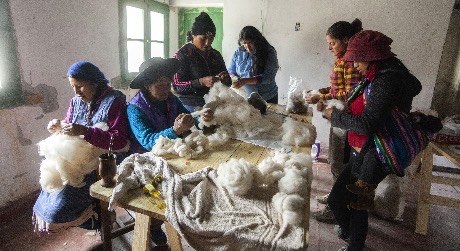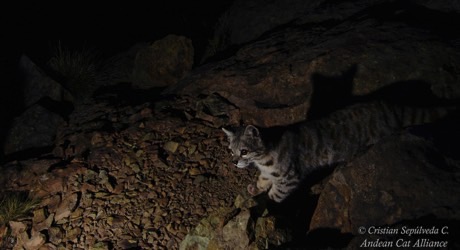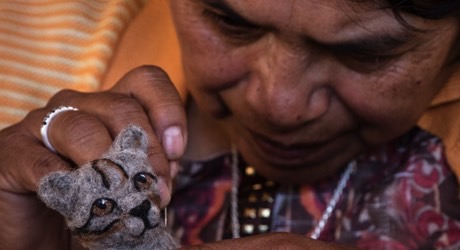The Andean cat is the most endangered feline in the Americas – only about 1,400 adults remain across Argentina, Chile, Peru, and Bolivia. This small cat represents a conservation priority not only because of its endangered status but also because it acts as an umbrella species – the health of its populations is directly tied to that of the High Andes ecosystem in which it lives. The main threats facing these cats are hunting and habitat loss.
Key Project Activities
The COVID-19 pandemic posed an unexpected challenge to our plans. For many months, all travel was banned, and even when traveling resumed, we restrained from visiting the remote communities with which we work to avoid spreading the virus. That considerably slowed our ability to spend the grant provided by World Nomads.
However, thanks to the internet access of most of the women we work with, we managed to transform this challenge into an opportunity. Initially, we provided information on measures to avoid contagion and supplies, and when the situation started to improve, we resumed training virtually.
The increasing ability of local communities to use social networks and virtual meeting apps allowed us to strengthen the artisans’ network and led to a training event where women from Argentina shared their knowledge on llama wool preparation and usage with women from Chile and Peru. More recently, we invited some of the artisans who gained the most from our trainings to become trainers themselves and start passing the lessons and skills they learned to new participants of the program.
Additionally, we organized the first Andean cat handicrafts competition that achieved the goal of keeping the participants of our program engaged and stimulated their creativity.
In 2021, when travel restrictions eased, we resumed fieldwork and successfully managed to expand our network by doubling the number of communities in our artisan network in each of the countries where we work. To reduce competition and to build on the existing skills and interests in these new communities, we started developing new products, which, in turn, enabled us to significantly expand our catalogue of products.
With this new list of handicrafts, we recently resumed sales, both directly in some shops and at fairs in Argentina and Peru.
Finally, with the help of a strategic partner and also thanks to a grant from the Peruvian government, we started selling our Chilean and Peruvian products online, which we see as critical to increase resilience of High Andes communities to epidemics and natural hazards through more stable income.
Key project learnings
We found the activities that engaged people from different countries particularly exciting because they gave us the opportunity to see women and men who come from the same ancestral culture, but are separated by political borders, share life experiences and knowledge. It was heartening for us when women who took part in our handicraft competition said to us, “Please, organize a new competition soon, because we enjoyed the challenge and want to create new products!”.
During all our trainings, we keep stressing our conservation education messaging, and emphasized the role of the Andean cat as a catalyst for the conservation of the natural heritage of the High Andes as well as a driver for positive societal changes, especially for women. This, in turn, is changing the attitudes and behaviors of local people towards Andean cats.
What's Next?
Although we consider that we have been very successful at overcoming the unforeseen limitations and challenges caused by the COVID-19 pandemic, it’s clear the situation has not gone back to normal. Tourists, who are our main customers, are still scarcer than three years ago and sales are still comparatively slow. Thus, we will continue working to keep program participants engaged and increase our conservation impact by expanding the geographical reach of our activities, supporting the creation of a network of selling points, and providing new training opportunities to local people.
Future training will particularly aim to increase digital and entrepreneurial skills, in order to reduce dependence of artisans – and young people – on the Andean Cat Alliance and enhance their resilience. We hope that soon the artisans who form part of our network will be self-sufficient and that AGA’s role will primarily be that of helping them with conservation initiatives funded with the help of the income generated by their sales.
However, we also plan to move beyond craftsmanship as a tool to increase the engagement of local communities in conservation. We aim to explore other sustainable, conservation-friendly sources of income to respond to the desires and requests by the people who live in contact with Andean cats.
Finally, we are deploying a set of camera traps in each of the three countries where we are working that will be checked by the residents of these local communities. Our goal is to evaluate the effects of our activities on the Andean cat populations and further increase communities’ engagement in conservation.
Can I visit this project?
Yes of course! We would be happy to receive visits from our donors!
Project background
The Andean cat is the most endangered feline in the Americas – only about 1,400 adults remain across Argentina, Chile, Peru, and Bolivia. This small cat represents a conservation priority not only because of its endangered status but also because it acts as an umbrella species – the health of its populations is directly tied to that of the High Andes ecosystem in which the species lives. The main threats facing these cats are hunting and habitat loss.
The long-term success of the Andean Cat Alliance’s efforts are strongly tied to the participation of local communities – without their buy-in, conservation will not succeed. The CATcrafts project is a way for us to engage these communities in conservation – community members earn an income, often for the first time in their lives, through creating high-quality handcrafts modelled after the Andean cat for international sale.
While participating in this alternative livelihood program, we also engage them in conservation education – reinforcing the value of the Andean cat and wildlife in general for the ecosystem. This serves to strengthen the bond between their cultural values, sustainable socio-economic development, and wildlife conservation. The program ultimately protects more Andean cats by changing the attitudes and behaviour of these communities.

Project overview
CATcrafts uses craftsmanship as a tool to enable the Andean Cat Alliance to create a connection between wildlife conservation and improved livelihoods in the High Andes communities. Handcrafted products form part of the cultural heritage and way of life of Andean communities and are part of local ancestral traditions. The goal of CATcrafts is to build upon this traditional background, increasing engagement of local communities in conservation of the Andean cat through the adoption of craftsmanship as form of income generation. Simultaneously, this initiative reinforces the cultural identity of the High Andes communities and its profound respect for wildlife and empowering native inhabitants.
Residents of these rural areas are among the poorest in their countries – and yet, they are also living at the front lines of wildlife conservation and have a direct impact on the local ecosystem. CATcrafts enables them to improve their livelihoods while also lessening their impact on the endangered species with whom they share space.
Through CATcrafts, they learn to combine ancient techniques with contemporary design to create artisan products for international sale, and thus, income generation. Along with earning an income, we also engage them in conservation education, so that the tie between this alternative livelihood program and wildlife conservation is clear. As they learn that their improved livelihoods are directly linked to wildlife conservation, we see their attitudes and behaviour towards Andean cats change for the better.

Our activities for the coming year will focus on improving the quality of the handcrafted products through additional training opportunities for the participating artisans. These trainings will incorporate our conservation education messaging, emphasizing the role of the Andean cat as a driver for positive change. We expect our long-term outcomes to include an increase in household incomes, and a continued improvement in attitudes and behaviours towards Andean cats.
What's covered in project cost
The $15,000 raised by the Footprints Network will go towards:
- Stipend for community members participating in CATcrafts as trainers/communicators (28 days at $25/day): $700
- CATcrafts Head Trainer salary (3 days/country x 3 countries at $200/day: $1,800
- Part-time stipend for Peruvian field coordinator (12 months at $125/month): $1,500
- Workshop organisation costs (3 workshops per country x 3 countries at $100/workshop): $900
- Andean Cat Alliance staff travel to workshops (3 trips per country x 3 countries at $600/trip): $5,400
- Project lead travel to field sites (one trip to Chile and one to Peru): $1,500
- Purchase of handicrafts at a fair value from artisans ($550/country x 3 countries): $1,650
- Supplies for artisans: $300
- Promotional material – conservation information to be included on handicraft product tags: $200
- Andean Cat Alliance travel to sale points (2 trips/country x 3 countries at $175/trip): $1,050

Partners and community involvement
In addition to the participating artisans themselves from the local communities, the CATcrafts project partners with the following organizations:
- Fundación Ona, Chile: this Chilean foundation works to promote traditional craftsmanship to revitalize the cultural heritage of local communities. We are working with their leader, Macarena Peña, to advertise and market the CATcrafts products through their network in Chile.
- Arte y Esperanza: this Argentinean NGO works to support local communities through fair trade. They are selling CATcrafts handicrafts in Buenos Aires, the biggest city of the country.
- SERNANP, Peru: this is the Peruvian Protected Area agency. We are working with them to get an eco-friendly certificate for CATcrafts products in this country.
- Mitchy Aiquina, Chile: this is the local cooperative of artisans that we are working with to improve community awareness in Chile.
- Llank´ay Maky, Argentina: this is the local cooperative of artisans that we are working with to improve community awareness in Argentina.
- Pucapaqocha, Peru: this is the local cooperative of artisans that we are working with in Peru.
Part of a larger strategy
When AGA was founded in 1999, information available on Andean cats was almost nonexistent. During our first decade, we focused on field research to assess the species’ conservation status and threats. This enabled us to see how critical a role local communities play in conservation – without their buy-in and involvement, effective conservation cannot happen.
More recently, we have dedicated increasing efforts to community engagement and livelihood improvement to reduce the impact of threats affecting the Andean cat. CATcrafts combines AGA’s research, education, and community experience to create a connection between the Andean cat and income generation. This work fits into our larger strategy because with more money in their pockets tied directly to the Andean cat, we see improvements in attitudes and behaviors from community members towards conservation – which in turn leads to less hunting and unsustainable resource use from the local ecosystem, ultimately benefitting both people and wildlife.